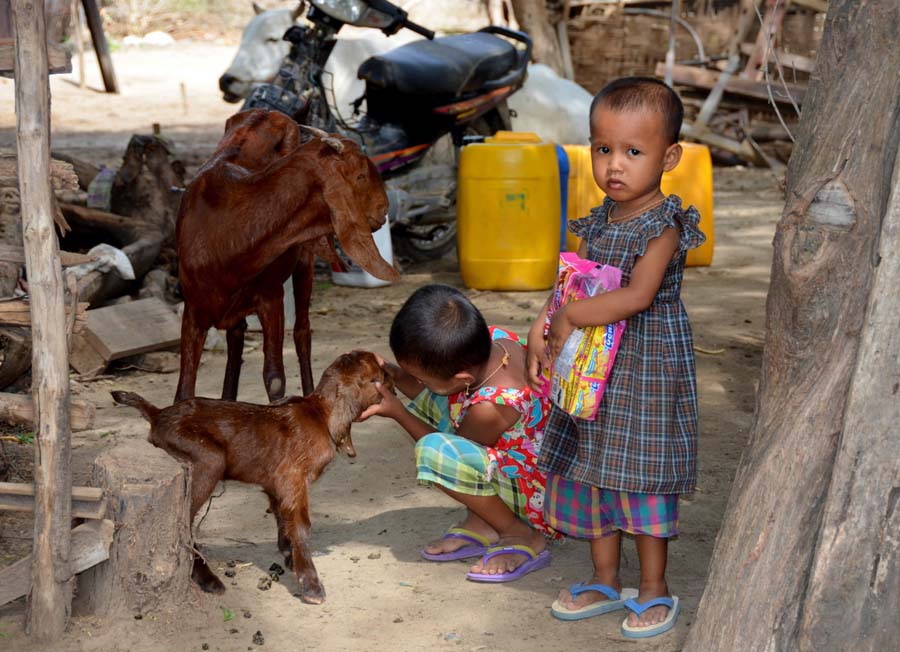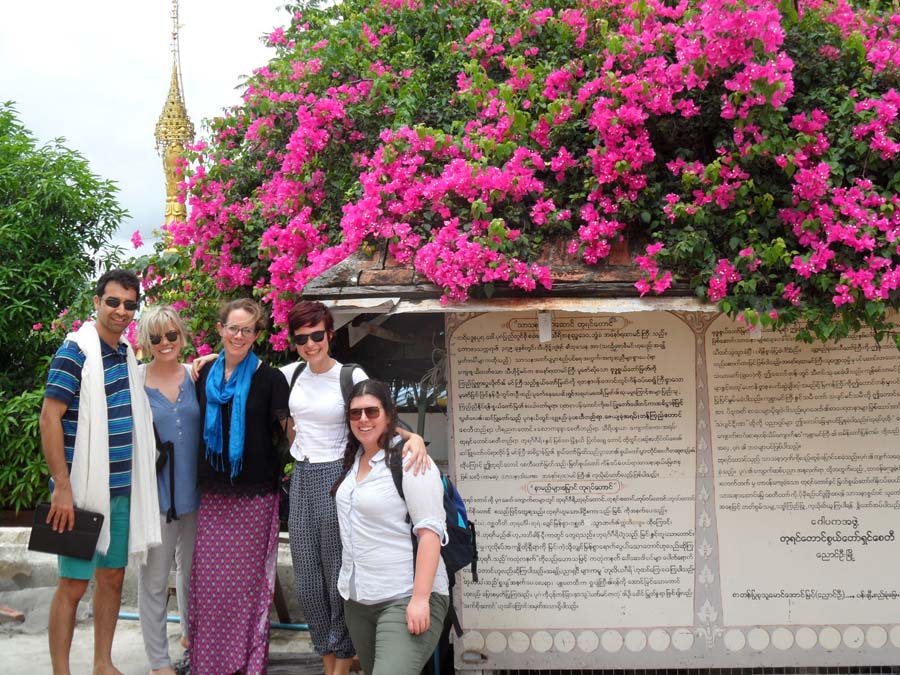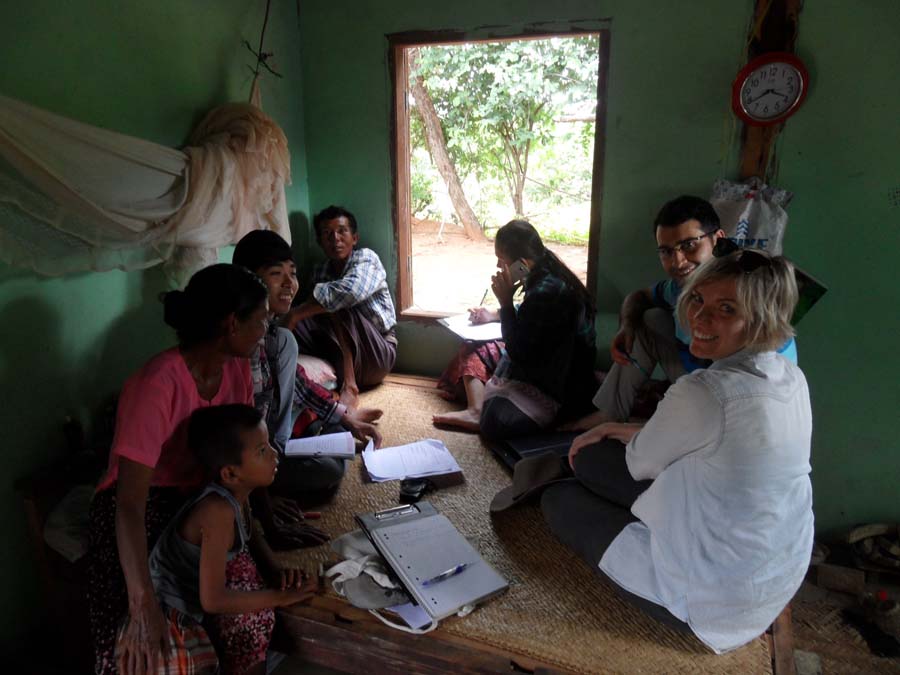Gifts from the Golden Land
“Raindrops on roses, and whiskers on kittens…” I am in a hotel lobby in Meiktila, Myanmar, singing a deeply expressive Sound of Music duet with my lecturer. Loudly! The proprietor of the hotel continues to chant his Buddhist mantras, pretending he doesn’t mind that his lobby has been turned into a makeshift laboratory, complete with centrifuge and 60 cattle blood samples.
My colleagues are running an ad hoc tutorial on making blood smears for the Myanmar veterinary students, while periodically stopping to join us in song as we make our way through the entire Julie Andrews back catalogue. I suspect the poor proprietor is looking forward to us leaving, we with our insistence on things like sheets on a bed and turning up with muddy clothes needing washing. However, Dr Angus Campbell and Dr Elsa Glanville have been coming here for years now, so maybe they are used to it.
Dr Angus has taken four of us final year DVM students to Meiktila to take part in the Dahat Pan project, a project between Australian and Myanmar researchers—the Livestock Breeding and Veterinary Department of Myanmar, the University of Veterinary Science Yezin, the University of Melbourne and the University of Queensland. The project is funded by the Australian Government through the Australian Centre for International Agricultural Research (ACIAR). We are studying cattle, small ruminant (goat and sheep), chicken and forage production in Myanmar, as well as looking at blood borne parasites in cattle and small ruminant nutrition. In addition, we are surveying the household demographics of the families participating in the project. It’s an awesome opportunity to see a veterinary development project in action, and I’ve been looking forward to it all year!

A budding vet at work!
I was so excited about this trip I even tried to learn to speak Myanmar. I would practice as I headed to uni at 4am to change ice boots on a laminitic donkey, dreaming of the day I would escape the university hospital and travel to the Golden Land. On arrival, I discover that my Myanmar language is in fact, appalling (accidentally ordering everyone at the table a glass of lime juice with a raw egg in it was a low point!). Fortunately, we are working with a group of Masters students from the University of Veterinary Science here in Myanmar. They start university at only 16, with the first year being an intensive course in the English language. After that first year, all classes are taught only in English! They act as interpreters as well as researchers, a challenging role that I do not envy!
We are heading into villages throughout the Central Dry Zone of Myanmar to collect our data. Last week we focused on assessing small ruminant nutrition and surveying the demographic data of the households involved in the project. The household surveys were a wonderful experience, in which we sat down with families while they told us how they lived. It was festival time over here, so we were usually brought platefuls of delicious fried chickpea crackers and Myanmar donuts, made of deep fried rice flour sweetened with palm sugar. As people concentrated on interviews and recording data, I felt I was eating for two as the women pressed more dishes on me. Fortunately, I have a large collection of elderly Polish relatives, so I have been in training for this moment my entire life.
Getting to know the families gave us really important information about how the animals are cared for – in one village, up to five members from each family has left to work in factories in Thailand, leaving them with a severe labour shortage. Many families have been forced to sell their stock as they do not have the time to shepherd them for miles each day to graze. One farmer is given a photograph of his sheep that was taken on the project’s last visit. ‘Mine? My sheep?’ he says, as he stares at the photo in wonder. He drifts off into a sad reverie, and clearly feels their loss keenly.
It is interesting to see the number of women involved with livestock farming, especially the small ruminants. At the farmer meetings we hold, most of the attendees are women. They have lots to say in discussion and are happy to share experiences, while the men tend to sit back and chew betel leaf.
Improving the nutrition of the small ruminants has helped reduce mortalities among their young, and the women and children benefit greatly from the increased income. They are clearly appreciative of the project – the women are especially happy to see Dr Elsa, who knows their names and asks about their children. I am impressed by the relationships the project has managed to develop, thanks to the time and effort put in by the research staff.

Enjoying Myanmar’s beauty in a moment of down time – from left, Omid Neishaboory, Ania Peterson, Elsa Glanville, Kelly Wood, Emily Dickson
Sadly, in the second week, the lovely long chats with farmers about their children are over, and we get down to business collecting the cattle blood. I tend to see cows as oversized, hostile lawn mowers, with a pointy/bitey end and a tendency to projectile-poo from the other.
There is no such thing as a cattle crush here, so farmers and local veterinary technicians hold the cattle for us while we collect the samples. They are wearing thongs and the traditional longii, a kind of sarong, in contrast to the boots and overalls we typically wear in Australia. The sampling proceeds relatively smoothly, some of the cattle are very well behaved, others clearly have aspirations to take up Spanish bull fighting, but the samples all manage to be collected. It is touching to witness the farmers stroking and speaking softly to their cows, reassuring them that this mad-woman in her large hat will go away very, very soon. The cattle and I are all extremely relieved when the process is over.
However, I will not be relieved when our Myanmar trip is over, but saddened. I have fallen in love with Myanmar – the pagodas peeking out from behind the almost fluorescent green jungle foliage, the energy of the streets and the warmth of the people. In Kyauk Aoe, a woman gives me a gift of sesame oil in a plastic water bottle. She has made the oil herself, sifting the seeds from the pods and then pressing them, all by hand. I am floored by the generosity of the gift – such a quantity would have taken ages to make, and the family earns $1300 AUD a year. I feel completely humbled. This experience has given me a real drive to keep working in veterinary development. I want this woman to have a well closer to her, so she does not have to walk so far to get water for the goats. I want the lambs and kids to survive infancy, so families and animals don’t suffer through the economic and emotional loss of 80% mortality rates. I want better access to treatments for FMD than some of the traditional methods. I want a better world, and that’s what the Dahat Pan project is working towards through working with farmers in Myanmar. I am so grateful to have been given this experience, and I hope I can find a way to keep contributing to this kind of work after graduation.

Surveying livestock owners to learn about their families with Omid


